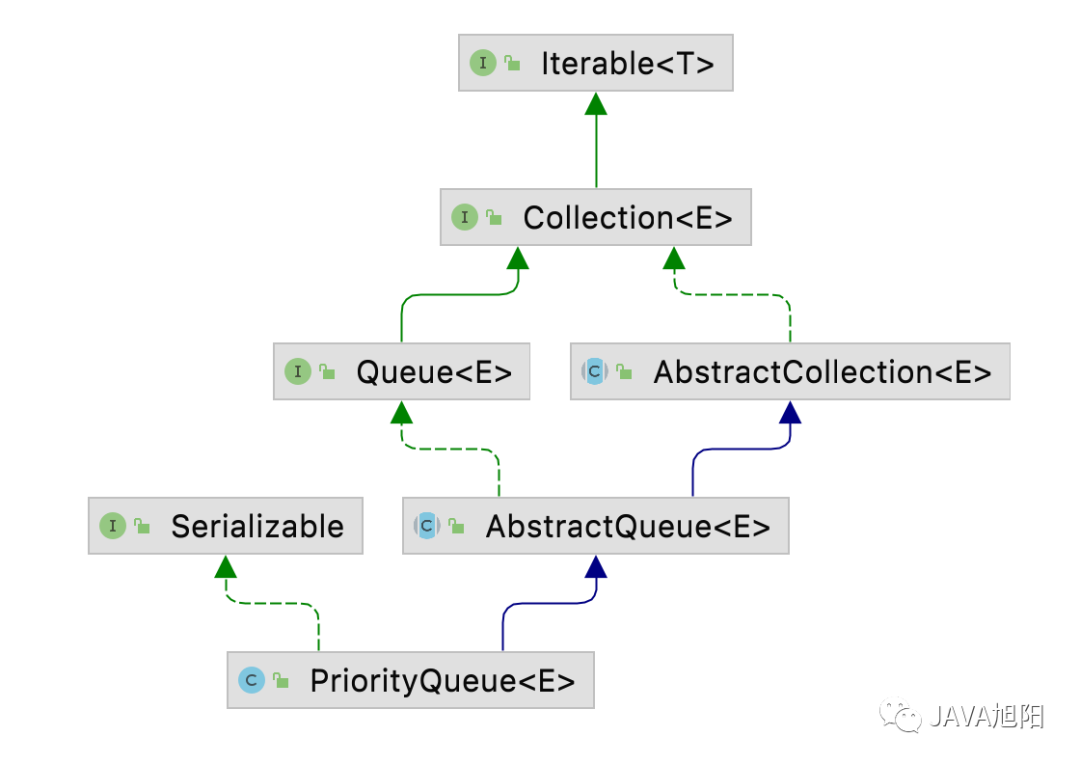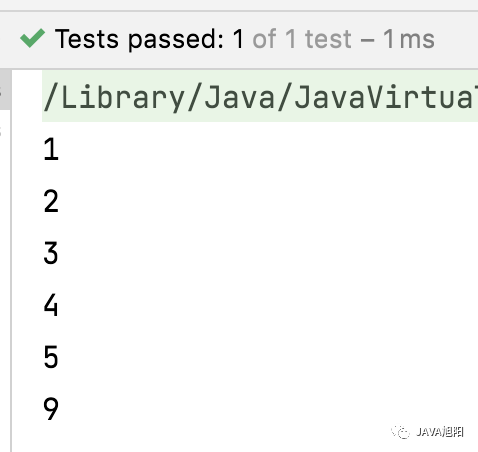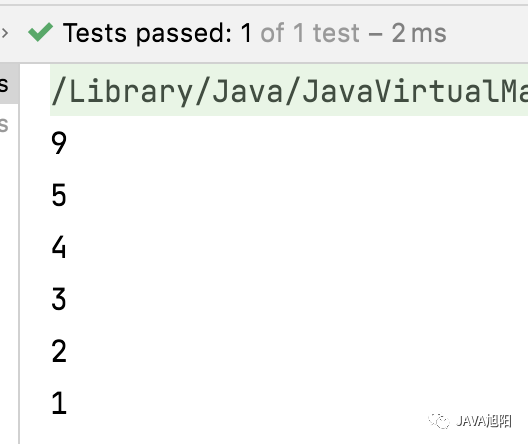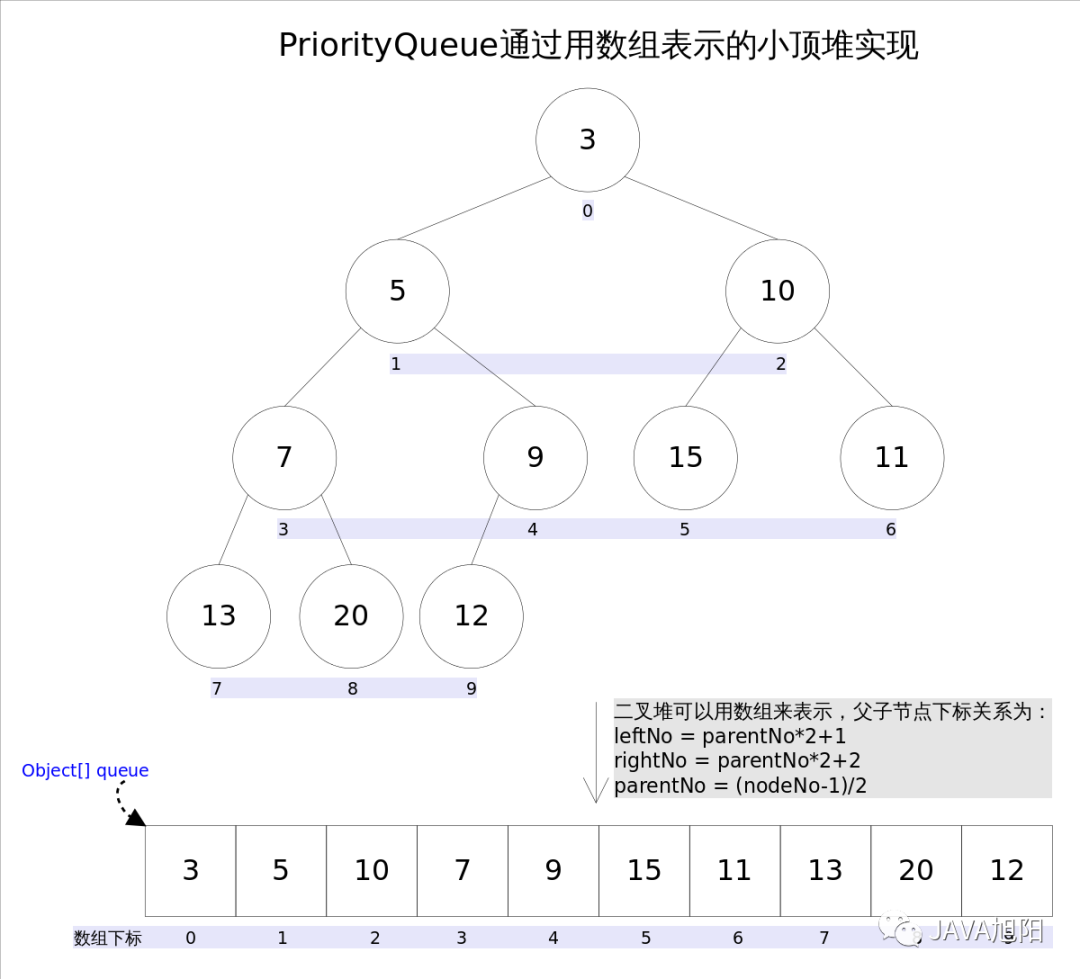優先隊列PriorityQueue,有空了解一下嗎?
前言
PriorityQueue這個隊列不知道大家使用過嗎,反正我用的很少,主要對它不是很了解,今天我帶領大家剖析下PriorityQueue這個優先級隊列。
PriorityQueue介紹
顧名思義,PriorityQueue是優先隊列的意思。優先隊列的作用是能保證每次取出的元素都是隊列中權值最小的。這里牽涉到了大小關系,元素大小的評判可以通過元素本身的自然順序(natural ordering),也可以通過構造時傳入的比較器。
- PriorityQueue實現了Queue接口,最大的特點是存取具有優先級,就是根據元素的順序來決定
- PriorityQueue是一個無界的容器
- PriorityQueue底層是基于堆實現的
- 不允許放入null元素
- PriorityQueue不是線程安全的
 圖片
圖片
以上是PriorityQueue的類圖,
- 繼承了AbstractQueue抽象類,實現了Queue接口,具備隊列的操作方法
- 實現了Seriablizable接口,支持序列化
構造方法
方法 | 說明 |
PriorityQueue() | 構造一個初始容量為11的優先隊列 |
PriorityQueue(Comparator<? super E> comparator) | 構造一個自定義排序器的優先隊列 |
PriorityQueue(SortedSet<? extends E> c) | 構造一個基于SortedSet內容的優先隊列 |
關鍵方法
方法 | 說明 |
add(E e) | 添加元素,如果超過隊列長度,拋出異常 |
offer(E e) | 添加元素,如果超過隊列長度返回false |
remove() | 獲取下個元素,如果沒有拋出異常 |
poll() | 獲取下個元素,如果沒有返回null |
element() | 查看下個元素的內容,如果沒有拋異常 |
peek() | 查看下個元素的內容,如果沒有返回null |
使用案例
- 優先隊列功能測試
@Test
public void test1() {
Queue<Integer> queue = new PriorityQueue<>();
queue.offer(5);
queue.offer(4);
queue.offer(1);
queue.offer(9);
queue.offer(3);
queue.offer(2);
// 打印,排序
Integer poll = null;
while ((poll = queue.poll()) != null) {
System.out.println(poll);
}
}運行結果:
 圖片
圖片
- 自定義排序器
@Test
public void test2() {
// 自定義排序,倒序
Queue<Integer> queue = new PriorityQueue<>(Collections.reverseOrder());
queue.offer(5);
queue.offer(4);
queue.offer(1);
queue.offer(9);
queue.offer(3);
queue.offer(2);
// 打印,排序
Integer poll = null;
while ((poll = queue.poll()) != null) {
System.out.println(poll);
}
}運行結果:
 圖片
圖片
實現機制
PriorityQueue通過堆實現,具體說是通過完全二叉樹(complete binary tree)實現的小頂堆(任意一個非葉子節點的權值,都不大于其左右子節點的權值),也就意味著可以通過數組來作為PriorityQueue的底層實現。
 圖片
圖片
上圖中我們給每個元素按照層序遍歷的方式進行了編號,如果你足夠細心,會發現父節點和子節點的編號是有聯系的,更確切的說父子節點的編號之間有如下關系:
leftNo = parentNo*2+1
rightNo = parentNo*2+2
parentNo = (nodeNo-1)/2
通過上述三個公式,可以輕易計算出某個節點的父節點以及子節點的下標。這也就是為什么可以直接用數組來存儲堆的原因。
源碼解析
成員變量
transient Object[] queue;
/**
* The number of elements in the priority queue.
*/
private int size = 0;
/**
* The comparator, or null if priority queue uses elements'
* natural ordering.
*/
private final Comparator<? super E> comparator;
/**
* The number of times this priority queue has been
* <i>structurally modified</i>. See AbstractList for gory details.
*/
transient int modCount = 0;- queue就是實際存儲元素的數組。
- size表示當前元素個數。
- comparator為比較器,可以為null。
- modCount記錄修改次數。
構造方法
public PriorityQueue(int initialCapacity,
Comparator<? super E> comparator) {
// Note: This restriction of at least one is not actually needed,
// but continues for 1.5 compatibility
if (initialCapacity < 1)
throw new IllegalArgumentException();
this.queue = new Object[initialCapacity];
this.comparator = comparator;
}- 初始化了queue和comparator
添加元素offer
public boolean offer(E e) {
// 如果元素為空,拋出空指針
if (e == null)
throw new NullPointerException();
// 修改次數+1
modCount++;
int i = size;
// 首先確保數組長度是夠的,如果不夠,調用grow方法動態擴展。
if (i >= queue.length)
grow(i + 1);
size = i + 1;
// 如果是第一次添加,直接添加到第一個位置即可 (queue[0]=e)
if (i == 0)
queue[0] = e;
else
// 否則將其放入最后一個位置,但同時向上調整,直至滿足堆的性質 (siftUp)
siftUp(i, e);
return true;
}private void grow(int minCapacity) {
int oldCapacity = queue.length;
// Double size if small; else grow by 50%
int newCapacity = oldCapacity + ((oldCapacity < 64) ?
(oldCapacity + 2) :
(oldCapacity >> 1));
// overflow-conscious code
if (newCapacity - MAX_ARRAY_SIZE > 0)
newCapacity = hugeCapacity(minCapacity);
queue = Arrays.copyOf(queue, newCapacity);
}如果原長度比較小,大概就是擴展為兩倍,否則就是增加50%,使用Arrays.copyOf方法拷貝數組。
private void siftUp(int k, E x) {
// 如果比較器為空
if (comparator != null)
siftUpUsingComparator(k, x);
else
siftUpComparable(k, x);
}private void siftUpUsingComparator(int k, E x) {
while (k > 0) {
int parent = (k - 1) >>> 1;
Object e = queue[parent];
if (comparator.compare(x, (E) e) >= 0)
break;
queue[k] = e;
k = parent;
}
queue[k] = x;
}參數k表示插入位置,x表示新元素。k初始等于數組大小,即在最后一個位置插入。代碼的主要部分是:往上尋找x真正應該插入的位置,這個位置用k表示。
怎么找呢?新元素(x)不斷與父節點(e)比較,如果新元素(x)大于等于父節點(e),則已滿足堆的性質,退出循環,k就是新元素最終的位置,否則,將父節點往下移(queue[k]=e),繼續向上尋找。
總結
優先級可以有相同的,內部元素不是完全有序的,如果遍歷輸出,除了第一個,其他沒有特定順序。查看頭部元素的效率很高,為O(1),入隊、出隊效率比較高,為O(log2(N)),構建堆的效率為O(N)。根據值查找和刪除元素的效率比較低,為O(N)。


































